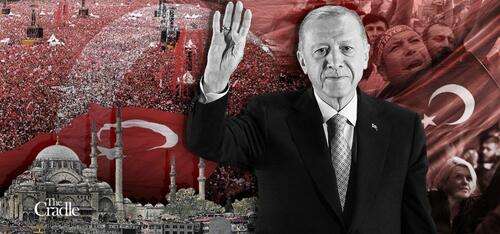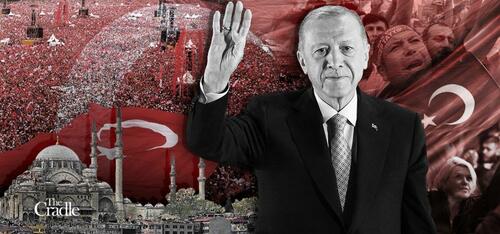Authored by Pepe Escobar via The Cradle,
It’s not that Erdogan has a scheme to head east at the west’s expense. It’s just that the world’s grandest infrastructure, development, and geopolitical projects are all in the east today…
The collective west was dying to bury him – yet another strategic mistake that did not take into account the mood of Turkish voters in deep Anatolia.
In the end, Recep Tayyip Erdogan did it – again. Against all his shortcomings, like an aging neo-Ottoman Sinatra, he did it “my way,” comfortably retaining Turkiye’s presidency after naysayers had all but buried him.
The first order of geopolitical priority is who will be named Minister of Foreign Affairs. The prime candidate is Ibrahim Kalin – the current all-powerful Erdogan press secretary cum top adviser.
Compared to incumbent Cavusoglu, Kalin, in theory, may be qualified as more pro-west. Yet it’s the Sultan who calls the shots. It will be fascinating to watch how Turkiye under Erdogan 2.0 will navigate the strengthening of ties with West Asia and the accelerating process of Eurasia integration.
The first immediate priority, from Erdogan’s point of view, is to get rid of the “terrorist corridor” in Syria. This means, in practice, reigning in the US-backed Kurdish YPG/PYD, who are effectively Syrian affiliates of the Kurdistan Workers’ Party (PKK) – which is also the issue at the heart of a possible normalization of relations with Damascus.
Now that Syria has been enthusiastically welcomed back to the Arab League after a 12-year freeze, a Moscow-brokered entente between the Turkish and Syrian presidents, already in progress, may represent the ultimate win-win for Erdogan: allowing control of Kurds in north Syria while facilitating the repatriation of roughly 4 million refugees (tens of thousands will stay, as a source of cheap labor).
The Sultan is at his prime when it comes to hedging his bets between east and west. He knows well how to profit from Turkiye’s status as a key NATO member – complete with one of its largest armies, veto power, and control of the entry to the uber-strategic Black Sea.
And all that while exercising real foreign policy independence, from West Asia to the Eastern Mediterranean.
So expect Erdogan 2.0 to remain an inextinguishable source of irritation for the neocons and neoliberals in charge of US foreign policy, along with their EU vassals, who will never refrain from trying to subdue Ankara to fight the Russia-China-Iran Eurasia integration entente. The Sultan, though, knows how to play this game beautifully.
How to manage Russia and China
Whatever happens next, Erdogan will not hop on board the sanctions-against-Russia sinking ship. The Kremlin bought Turkish bonds tied to the development of the Russian-built Akkuyu nuclear power plant, Turkiye’s first nuclear reactor. Moscow allowed Ankara to postpone nearly $4 billion in energy payments until 2024. Best of all, Ankara pays for Russian gas in rubles.
So an array of deals related to the supply of Russian energy trump possible secondary sanctions that might target the steady rise in Turkiye’s exports. Still, it’s a given the US will revert to its one and only “diplomatic” policy – sanctions. The 2018 sanctions did push Turkiye into recession after all.
But Erdogan can easily count on popular support across the Turkish realm. Early this year, a Gezici poll revealed that 72.8 percent of Turkish citizens privilege good relations with Russia while nearly 90 percent rate the US as a “hostile” nation. That’s what allows Interior Minister Soylu to remark, bluntly, “we will wipe out whoever is causing trouble, including American troops.”
China-Turkiye strategic cooperation falls under what Erdogan defines as “turning to the East” – and is mostly about China’s multi-continent infrastructure behemoth, the Belt and Road Initiative (BRI). The Turk Silk Road branch of the BRI focuses on what Beijing defines as the “Middle Corridor,” a prime cost-effective/secure trade route that connects Asia to Europe.
The driver is the China Railway Express, which turned the Middle Corridor arguably into BRI’s backbone. For instance, electronics parts and an array of household items routinely arriving via cargo planes from Osaka, Japan are loaded onto freight trains going to Duisburg and Hamburg in Germany, via the China Railway Express departing from Shenzhen, Wuhan, and Changsha – and crossing from Xinjiang to Kazakhstan and beyond via the Alataw Pass. Shipments from Chongqing to Germany take a maximum of 13 days.
It’s no wonder that nearly 10 years ago, when he first unveiled his ambitious, multi-trillion dollar BRI in Astana, Kazakhstan, Chinese President Xi Jinping placed the China Railway Express as a core BRI component.
Direct freight trains from Xian to Istanbul are plying the route since December 2020, using the Baku-Tblisi-Kars (BTK) railway with less than two weeks travel time – and plans afoot to increase their frequency. Beijing is well aware of Turkiye’s asset as a transportation hub and crossroads for markets in the Balkans, the Caucasus, Central Asia, West Asia, and North Africa, not to mention a customs union with the EU that allows direct access to European markets.
Moreover, Baku’s victory in the 2020 Nagorno-Karabakh war came with a ceasefire deal bonus: the Zangezur corridor, which will eventually facilitate Turkiye’s direct access to neighbors from the Caucasus to Central Asia.
A pan-Turkic offensive?
And here we enter a fascinating territory: the possible incoming interpolations between the Organization of Turkic States (OTS), the Shanghai Cooperation Organization (SCO), the BRICS+ – and all that also linked to a boost in Saudi and Emirati investments in the Turkish economy.
Sultan 2.0 wants to become a full member of both the Chinese-led SCO and multipolar BRICS+.
This means a much closer entente with the Russia-China strategic partnership as well as with the Arab powerhouses, which are also hopping on the BRICS+ high-speed train.
Erdogan 2.0 is already focusing on two key players in Central Asia and South Asia: Uzbekistan and Pakistan. Both happen to be SCO members.
Ankara and Islamabad are very much in sync. They express the same judgment on the extremely delicate Kashmir question, and both backed Azerbaijan against Armenia.
But the key developments may lie in Central Asia. Ankara and Tashkent have a strategic defense agreement – including intel sharing and logistics cooperation.
The Organization of Turkic States (OTS), with a HQ in Istanbul, is the prime energizer of pan-Turkism or pan-Turanism. Turkiye, Azerbaijan, Kazakhstan, Uzbekistan, and Kyrgyzstan are full members, with Afghanistan, Turkmenistan, Hungary, and Ukraine cultivated as observers. The Turk-Azeri relationship is billed as “one nation, two states” in pan-Turkic terms.
The basic idea is a still hazy “cooperation platform” between Central Asia and the Southern Caucasus. Yet some serious proposals have already been floated. The OTS summit in Samarkand late last year advanced the idea of a TURANCEZ free trade bloc, comprising Turkiye, Kazakhstan, Kyrgyzstan, Uzbekistan, Turkmenistan, Azerbaijan, and as observers, Hungary (representing the EU) and Northern Cyprus.
Meanwhile, hard business prevails. To fully profit from the status of the energy transit hub, Turkiye needs not only Russian gas but also gas from Turkmenistan feeding the Trans-Anatolian Natural Gas Pipeline (TANAP) as well as Kazakh oil coming via the Baku-Tblisi-Ceyhan (BTC) pipeline.
The Turkish Cooperation and Coordination Agency (TIKA) is heavy on economic cooperation, active in a series of projects in transportation, construction, mining, and oil and gas. Ankara has already invested a whopping $85 billion across Central Asia, with nearly 4,000 companies scattered across all the “stans.”
Of course, when compared to Russia and China, Turkiye is not a major player in Central Asia. Moreover, the bridge to Central Asia goes via Iran. So far, rivalry between Ankara and Tehran seems to be the norm, but everything may change, lightning fast, with the simultaneous development of the Russia-Iran-India-led International North South Transportation Corridor (INSTC), which will profit both – and the fact that the Iranians and Turks may soon become full BRICS+ members.
Sultan 2.0 is bound to boost investment in Central Asia as a new geoeconomic frontier. That in itself encapsulates the possibility of Turkiye soon joining the SCO.
We will then have a “turning to the East” in full effect, in parallel to closer ties with the Russia-China strategic partnership. Take note that Turkiye’s ties with Kazakhstan, Uzbekistan, and Kyrgyzstan are also strategic partnerships.
Not bad for a neo-Ottoman who, until a few days ago, was dismissed as a has-been.








